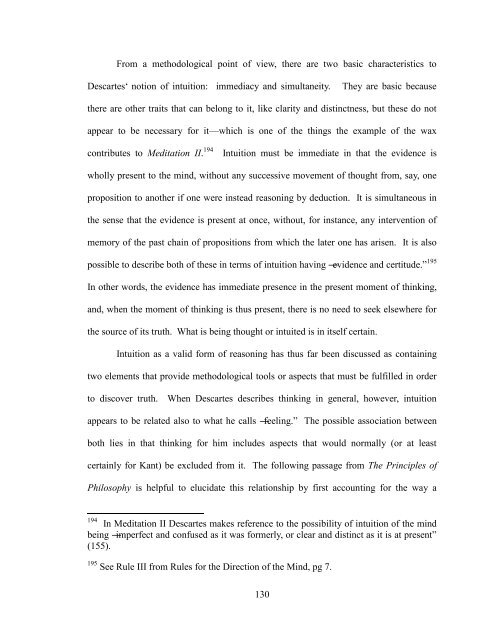The Doctrine of Self-positing and Receptivity in Kant's Late ...
The Doctrine of Self-positing and Receptivity in Kant's Late ...
The Doctrine of Self-positing and Receptivity in Kant's Late ...
You also want an ePaper? Increase the reach of your titles
YUMPU automatically turns print PDFs into web optimized ePapers that Google loves.
From a methodological po<strong>in</strong>t <strong>of</strong> view, there are two basic characteristics to<br />
Descartes‘ notion <strong>of</strong> <strong>in</strong>tuition: immediacy <strong>and</strong> simultaneity. <strong>The</strong>y are basic because<br />
there are other traits that can belong to it, like clarity <strong>and</strong> dist<strong>in</strong>ctness, but these do not<br />
appear to be necessary for it—which is one <strong>of</strong> the th<strong>in</strong>gs the example <strong>of</strong> the wax<br />
contributes to Meditation II. 194 Intuition must be immediate <strong>in</strong> that the evidence is<br />
wholly present to the m<strong>in</strong>d, without any successive movement <strong>of</strong> thought from, say, one<br />
proposition to another if one were <strong>in</strong>stead reason<strong>in</strong>g by deduction. It is simultaneous <strong>in</strong><br />
the sense that the evidence is present at once, without, for <strong>in</strong>stance, any <strong>in</strong>tervention <strong>of</strong><br />
memory <strong>of</strong> the past cha<strong>in</strong> <strong>of</strong> propositions from which the later one has arisen. It is also<br />
possible to describe both <strong>of</strong> these <strong>in</strong> terms <strong>of</strong> <strong>in</strong>tuition hav<strong>in</strong>g ―evidence <strong>and</strong> certitude.‖ 195<br />
In other words, the evidence has immediate presence <strong>in</strong> the present moment <strong>of</strong> th<strong>in</strong>k<strong>in</strong>g,<br />
<strong>and</strong>, when the moment <strong>of</strong> th<strong>in</strong>k<strong>in</strong>g is thus present, there is no need to seek elsewhere for<br />
the source <strong>of</strong> its truth. What is be<strong>in</strong>g thought or <strong>in</strong>tuited is <strong>in</strong> itself certa<strong>in</strong>.<br />
Intuition as a valid form <strong>of</strong> reason<strong>in</strong>g has thus far been discussed as conta<strong>in</strong><strong>in</strong>g<br />
two elements that provide methodological tools or aspects that must be fulfilled <strong>in</strong> order<br />
to discover truth. When Descartes describes th<strong>in</strong>k<strong>in</strong>g <strong>in</strong> general, however, <strong>in</strong>tuition<br />
appears to be related also to what he calls ―feel<strong>in</strong>g.‖ <strong>The</strong> possible association between<br />
both lies <strong>in</strong> that th<strong>in</strong>k<strong>in</strong>g for him <strong>in</strong>cludes aspects that would normally (or at least<br />
certa<strong>in</strong>ly for Kant) be excluded from it. <strong>The</strong> follow<strong>in</strong>g passage from <strong>The</strong> Pr<strong>in</strong>ciples <strong>of</strong><br />
Philosophy is helpful to elucidate this relationship by first account<strong>in</strong>g for the way a<br />
194 In Meditation II Descartes makes reference to the possibility <strong>of</strong> <strong>in</strong>tuition <strong>of</strong> the m<strong>in</strong>d<br />
be<strong>in</strong>g ―imperfect <strong>and</strong> confused as it was formerly, or clear <strong>and</strong> dist<strong>in</strong>ct as it is at present‖<br />
(155).<br />
195 See Rule III from Rules for the Direction <strong>of</strong> the M<strong>in</strong>d, pg 7.<br />
130


